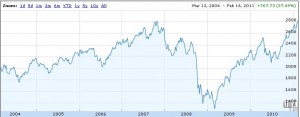The Nasdaq finished within 25 points of its highest level in a decade Friday, reminding investors of a time many would rather forget: The bursting of the dot-com bubble. The Nasdaq composite index closed Friday at 2,834, still only a little more than half its all-time closing high of 5,049 in March 2000. But the index of mostly tech stocks is up 26 percent over the past 12 months.

Should investors be worried about another bubble? Not really, because there’s a twist this time around: Technology companies are making money and may valued correctly.
“It is night and day compared to 10 years ago,” says Barry Mills, the manager of the $400 million Dreyfus Technology Growth fund. “These business models are real. The revenues are real, and the cash flows are real.”
Consider this: Judging by diluted earnings per share, a conservative method of valuing what a company’s stocks are worth, the companies in the Nasdaq index were collectively earning $39.28 per share in December 1999 and priced at 103.6 times their annual earnings. Now, the index has diluted earnings per share of $127.64 and a price-earnings ratio of 22.11.
The economic recovery in the U.S. is one reason that technology companies are earning such high profits. Companies put off upgrading their computer systems and other large purchases during the worst days of the recession, and are making up for that now. Others are investing in new technology before they add employees.
International growth is another reason to be optimistic. Half of the profits of the technology companies in the Standard & Poor’s 500 index come from outside North America, says Bill Stone, chief investment strategist at PNC Asset Management. China is now the world’s second-largest market for PCs, and consumers in emerging market countries are showing strong demand for smart phones.
Technology companies in the S&P 500, a close proxy for the Nasdaq composite, are up 8.4 percent so far this year, about 2 percentage points more than the index as a whole. Last year, tech companies returned 10 percent after dividends, compared with the 15 percent return of the full index.




